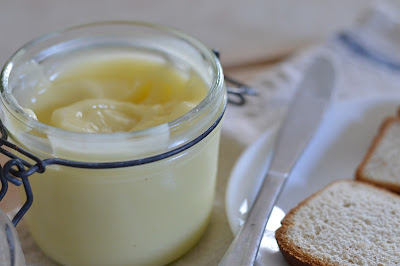Homemade Mayonnaise // Never Tasted so Good
Mayonnaise. A classic. Always on the grocery store shelves and always in the fridge at home. Used to make anything from chicken salad to a Chocolate Mayonnaise Cake handed down to us from generations past. Mayonnaise. Creamy, white, and delectable... how can something taste so good with so few ingredients?
I was watching the movie Julie and Julia one evening and in the movie Julia Child (played by Meryl Streep) was discussing with her friends how to make full-proof mayonnaise and I was intrigued. I know what you're thinking... intrigued about mayonnaise? I love learning about food, especially food items that were made before the electric age. I'm always curious as to how they did it and as I was sitting there on my cozy couch watching Julia Child explain full-proof mayonnaise, I was hooked.
When I began investigating mayonnaise recipes and trying them out I realized that there are far less ingredients in homemade mayonnaise than store bought. I decided to take a look at the ingredients listed on the last jar of my store bought mayonnaise to see what was in there. To my shock (well, not really) the very first ingredient was vegetable oil (soy and canola oil). Other ingredients listed that aren't so great were, corn syrup, natural flavor (has anyone figured out what that is exactly?), and calcium disodium to protect the flavor.
The first ingredient was enough for me to make the switch. Soybean oil and soybeans in general are not that great for us. According to the USDA over 90 percent of soybeans grown and harvested are genetically engineered. The purpose of genetically modifying the seed is so that it can withstand the pesticides being sprayed on the plant. So by ingesting soybean oil, which by the way is found in many of our foods, we are not only ingesting corrupted seed, but residues from the pesticides. Another reason to avoid soy is it mimics the effects of estrogen, a hormone found in the female body, and ingesting too much soy can cause imbalance, especially in men . Studies show soybean oil can be linked to inflammation, obesity, increase cardiovascular disease, not to mention the process in which the oil has to be refined requires many harsh chemical solvents (Joseph, M). Also the eggs used in most commercial mayonnaise are fed soy grain... a double-whammy for soy!
After reading all of this information I was further motivated to make my own mayonnaise... one less thing with soybean oil we would be ingesting. Let the fun begin! I tried a couple of recipes and came back to Julia Child's. Below is a excerpt from Julia Child's cookbook called From Julia Child's Kitchen. After trying homemade mayonnaise her descriptive, witty, blunt explanation about homemade mayonnaise was perfectly said and gave me a little giggle.
"Homemade mayonnaise, your own brand, with its wonderful taste of fresh eggs, fresh lemon, and the best oil is such an unexpected pleasure to those who have forgotten what mayonnaise should taste like-and such a revelation to those who have never enjoyed it before-that you find yourself thinking up every excuse to use it... Mayonnaise is also something every cook must confidently and rapidly whip up on command with nary a qualm, because it is one of the elemental cookery procedures." (Child, 439)
Fresh, high quality ingredients are extremely important when making mayonnaise. It is also vitally important that you use an extra light olive oil. Click here to review the brand that has worked really well for me. If using farm-fresh eggs make sure that the chickens are being properly cared for and fed a non-GMO feed diet. Be sure to wash the outside of the eggs thoroughly before cracking open too.
By now your mouth should be watering for a tomato sandwich, chicken salad, turkey club, or whatever you enjoy with mayonnaise! When I first tried homemade mayonnaise I was shocked at how amazingly good it was. Not only was the flavor impeccable, but it was wonderfully fresh!
Below my daughter is enjoying a turkey sandwich with "turkey sauce" (our code word for mayonnaise) and she loves it! Now I know exactly what ingredients are going into this condiment so I can feel good about feeding it to her and she's truly receiving good fats, which are great for brain development.
condiments

Homemade Mayonnaise
prep time: 10 minscook time: total time: 10 mins
So amazingly fresh tasting you'll wonder why you haven't made this before! Very easy to make and well worth the effort.
ingredients:
- 3 egg yolks
- 1/4 teaspoon dry mustard
- 1/2 teaspoon of fine sea salt
- 1 tablespoon fresh lemon juice and/or wine vinegar
- 2 cups of extra light olive oil
- Salt and pepper to taste
instructions:
- Beat egg yolks with a wire whisk for 2 to 3 minutes, until pale, thick like the texture of mayonnaise.
- Add mustard, salt, and a teaspoon of lemon juice or vinegar and beat for another minute.
- Next, in tiny droplets, begin beating the oil into the mixture, and don't stop beating until 1/2 a cup of the oil has been incorporated and the sauce becomes thick like mayonnaise.
- Add the last 2 teaspoons of lemon juice or vinegar and continue whisking while adding the rest of the oil in tiny droplets until all is incorporated. Make sure that there is an allotment of time whisking in between adding the droplets of oil.
- Once mayonnaise reaches desired thickness, add salt and pepper to taste. If mayonnaise is too thick, add more lemon juice or vinegar to thin out to desired consistency.
- Transfer completed mayonnaise to an airtight container and store in fridge. Mayonnaise will keep in the fridge up to 5 to 6 days.
NOTES:
This recipe may be whisked by hand or made with an electric mixer. It is vitally important that the oil is added slowly to avoid the mayonnaise turning runny. If this occurs, start over, but instead of using new oil, add the runny mayonnaise to the new batch as your "oil." When using mayonnaise, allow it to reach room temperature after pulling out of fridge before stirring, otherwise, the egg yolks may release the oil from the emulsion.
Created using The Recipes Generator
References:
Child, Julia.From Julia Child's Kitchen. New York:Gramercy Books, 1970.
Joseph, Michael.(2018, August 9). 8 Harmful Side effects of Soybean Oil. Retrieved from
https://www.nutritionadvance.com/harmful-effects-of-soybean-oil/
Wechsler, Seth J. (2018, July 16). Recent Trends in GE Adoption. Retrieved from
https://www.ers.usda.gov/data-products/adoption-of-genetically-engineered-crops-in-the-us/recent-trends-in-ge-adoption.aspx











Comments
Post a Comment